
Jumping spiders or the Salticidae are a family of spiders. As of 2019, it contained over 600 described genera and over 6,000 described species, making it the largest family of spiders at 13% of all species. Jumping spiders have some of the best vision among arthropods and use it in courtship, hunting, and navigation. Although they normally move unobtrusively and fairly slowly, most species are capable of very agile jumps, notably when hunting, but sometimes in response to sudden threats or crossing long gaps. Both their book lungs and tracheal system are well-developed, and they use both systems. Jumping spiders are generally recognized by their eye pattern. All jumping spiders have four pairs of eyes, with the anterior median pair being particularly large.
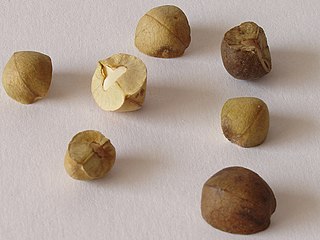
Mexican jumping beans are seed pods that have been inhabited by the larva of a small moth and are native to Mexico. The "bean" is usually tan to brown. It "jumps" when mildly heated. They are from the shrub Sebastiania pavoniana, often also referred to as "jumping bean". However, they are not related to actual beans, but rather to spurges. The beans are considered non-toxic but are not generally eaten.
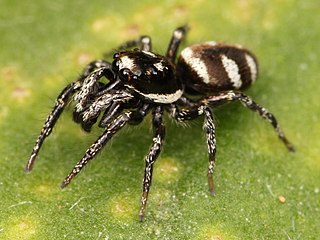
The zebra jumping spider is a common jumping spider of the Northern Hemisphere. Their common name refers to their vivid black-and-white colouration, whilst their scientific name derives from Salticus from the Latin for “dancing”, in reference to their agility, and the Greek scenicus, translating to “theatrical” or “of a decorative place,” in reference to the flashy, zebra-like coloration of the species.

A bolas spider is a member of the orb-weaver spider that, instead of spinning a typical orb web, hunts by using one or more sticky "capture blobs" on the end of a silk line, known as a "bolas". By swinging the bolas at flying male moths or moth flies nearby, the spider may snag its prey rather like a fisherman snagging a fish on a hook. Because of this, they are also called angling or fishing spiders. The prey is lured to the spider by the production of up to three sex pheromone-analogues.
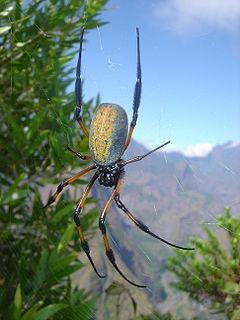
Trichonephila inaurata, synonym Nephila inaurata, commonly known as the red-legged golden orb-weaver spider or red-legged nephila, is a species of orb-weaver spider of the genus Trichonephila. It is native to southern and East Africa, as well as several islands of the western Indian Ocean.

Ant mimicry or myrmecomorphy is mimicry of ants by other organisms. Ants are abundant all over the world, and potential predators that rely on vision to identify their prey, such as birds and wasps, normally avoid them, because they are either unpalatable or aggressive. Spiders are the most common ant mimics. Additionally, some arthropods mimic ants to escape predation, while others mimic ants anatomically and behaviourally to hunt ants in aggressive mimicry. Ant mimicry has existed almost as long as ants themselves; the earliest ant mimics in the fossil record appear in the mid Cretaceous alongside the earliest ants. Indeed one of the earliest, Burmomyrma, was initially classified as an ant.

Phaeacius is a spider genus of the family Salticidae, found in sub-tropical China and between India and the Malay Peninsula, including Sri Lanka, Sumatra and the Philippines. Although other spiders can jump, salticids including Phaeacius have significantly better vision than other spiders, and their main eyes are more acute in daylight than a cat's and 10 times more acute than a dragonfly's. The main eyes focus accurately on an object at distances from approximately 2 centimetres (0.79 in) to infinity, and in practice can see up to about 75 centimetres (30 in). They do not spin webs.
Spider behavior refers to the range of behaviors and activities performed by spiders. Spiders are air-breathing arthropods that have eight legs and chelicerae with fangs that inject venom. They are the largest order of arachnids and rank seventh in total species diversity among all other groups of organisms which is reflected in their large diversity of behavior.

Choreutidae, or metalmark moths, are a family of insects in the lepidopteran order whose relationships have been long disputed. It was placed previously in the superfamily Yponomeutoidea in family Glyphipterigidae and in superfamily Sesioidea. It is now considered to represent its own superfamily. The relationship of the family to the other lineages in the group "Apoditrysia" need a new assessment, especially with new molecular data.

Myrmaplata plataleoides, also called the Red Weaver-ant mimicking jumper, is a jumping spider that mimics the Asian weaver ant in morphology and behaviour. This species is found in India, Sri Lanka, China and many parts of Southeast Asia.

Aggressive mimicry is a form of mimicry in which predators, parasites, or parasitoids share similar signals, using a harmless model, allowing them to avoid being correctly identified by their prey or host. Zoologists have repeatedly compared this strategy to a wolf in sheep's clothing. In its broadest sense, aggressive mimicry could include various types of exploitation, as when an orchid exploits a male insect by mimicking a sexually receptive female, but will here be restricted to forms of exploitation involving feeding. An alternative term Peckhamian mimicry has been suggested, but is seldom used. For example, indigenous Australians who dress up as and imitate kangaroos when hunting would not be considered aggressive mimics, nor would a human angler, though they are undoubtedly practising self-decoration camouflage. Treated separately is molecular mimicry, which shares some similarity; for instance a virus may mimic the molecular properties of its host, allowing it access to its cells.
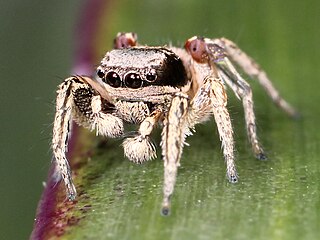
Salticoida is an unranked clade of the jumping spider family Salticidae. It is the larger and more widespread of the two subdivisions of the "typical" jumping spiders, occurring effectively world-wide. Its sister clade is Amycoida, which is also very diverse ecologically but has a mostly South American distribution.

Ultimo is a Japanese manga series created by American comic writer Stan Lee and illustrated by Hiroyuki Takei. The plot of the story depicts a conflict between good and evil, implicated through the Karakuri Dôji created by the character Dr. Dunstan. The pilot chapter "Karakuri Dôji Ultimo Chapter: 0" was originally published in a special issue of Jump Square, called Jump SQ.II, on April 18, 2008. The series Ultimo was first serialized in Jump Square in March 2009, and it continued monthly serialization. Shueisha also published Ultimo in tankōbon format—the first published on July 3, 2009, and the fifth on November 4, 2010.

Spiders are air-breathing arthropods that have eight legs, chelicerae with fangs generally able to inject venom, and spinnerets that extrude silk. They are the largest order of arachnids and rank seventh in total species diversity among all orders of organisms. Spiders are found worldwide on every continent except for Antarctica, and have become established in nearly every land habitat. As of August 2021, 49,623 spider species in 129 families have been recorded by taxonomists. However, there has been dissension within the scientific community as to how all these families should be classified, as evidenced by the over 20 different classifications that have been proposed since 1900.

Bembecia ichneumoniformis, the six-belted clearwing, is a moth of the family Sesiidae.
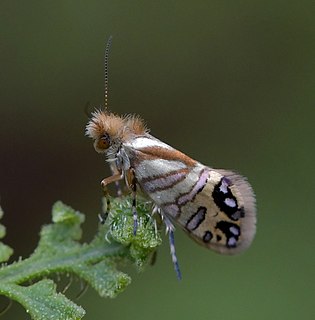
Sabatinca doroxena is a species of moth belonging to the family Micropterigidae. It is endemic to the North Island of New Zealand. This small moth has a colourful forewing pattern with stripes and dots evident. It has been hypothesised that the forewing pattern is intended to resemble a jumping spider in order to allow the adult moth to escape predation. Adults of this species are on the wing from the beginning of September until mid January. It prefers damp but sunny habitat in deep forest, at the forest edge or in open shrubland. Larvae feed on foliose liverwort species including on Heteroscyphus normalis. Adults of this species have been located at the blossoms of flowering Cordyline and Ranunculus species.
Brenthia leptocosma is a species of moth of the family Choreutidae. It is found on Mauritius and Réunion in the Indian Ocean.
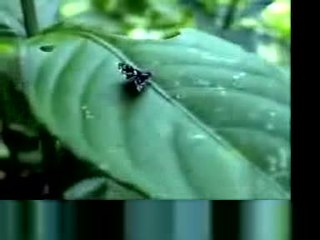
Brenthia hexaselena is a species of moth of the family Choreutidae. It is found in Costa Rica. It is a rare example of a prey animal mimicking its predator.

Brenthia monolychna is a species of moth of the family Choreutidae. It is found in Costa Rica.
Locomotor mimicry is a subtype of Batesian mimicry in which animals avoid predation by mimicking the movements of another species phylogenetically separated. This can be in the form of mimicking a less desirable species or by mimicking the predator itself. Animals can show similarity in swimming, walking, or flying of their model animals.















